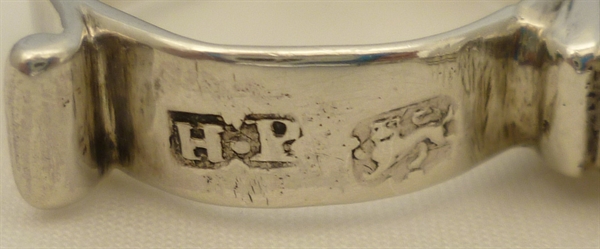| INDEX | ALL SILVER |
| HENRY PLUMPTON | I see so many of Henry's nips that I consider him worth a mention. I have actually never seen his mark on anything other than cast
sterling silver mid-18th century sugar nips or tea tongs, as they were termed at the time. Sometimes he wrote his name as Plimpton but illiteracy was high
among artisans and accurate spelling optional. I think he was a Plumpton so that is what I shall call him.
His father, John Plumpton, was a mariner from Saint John's, Wapping, Middlesex. Wapping, a parish since 1694, was close to the river Thames and populated with all the maritime trades. Probably due to the early death of his father, Henry took a different path and was apprenticed to John Blunt of the Merchant Taylor's Company on 4th April 1733. The seven year apprenticeship cost him £20. John Blunt had become free of his apprenticeship only one year before accepting Henry and when Henry became free on 2nd April 1740 the two set of together as journeyman goldsmiths (silversmiths). The only existing registered mark for Henry (alone) gives his address as Maiden Lane, which is in Covent Garden, on 14th November 1761. He is also mentioned in the Parliamentary Report of 1773 as 'smallworker' near Wapping Old Stairs. There would have been other marks but I expect they are lost in the two 'missing registers' that were destroyed by the fire at the old Houses of Parliament on 16th October 1834. The book for smallworkers covering 1739-1758 was one of those lost and most of the pieces by Henry that I have seen have the sterling passant used 1739-1756. I conject that Henry had a small but thriving business specialising in the manufacture of sugar nips based in Covent Garden from sometime in the 1740s until at least the early 1760s. From the early 1760s the fashion changed swiftly from nips to tongs and so Henry returned back home to Wapping, his sugar nips trade now over. I like to think of him in comfortable semi-retirement down by the river, working occasionally as a jobbing silversmith whenever he choose but I doubt that was the case. Life was hard for most artisans in Georgian England and picking up odd jobs from other makers would have earned him very little. This may also explain why we do not see Henry's own mark appearing towards the end of his working life. |

| Available Antique Sterling Silver Sugar Nips |
| email questions to silfren@btinternet.com
telephone 07563 011924 experts available 24 hours every day |